Main Body
Module 8 How Does Gender Operate in College and the Workplace?
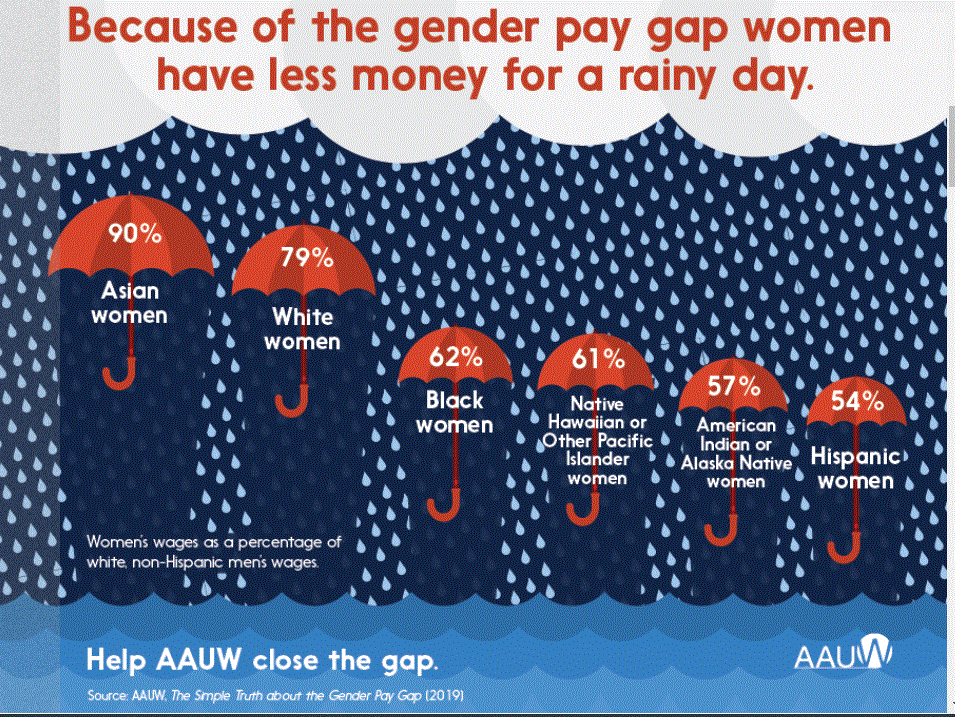
College and Career Interests
To improve women’s financial earnings, they now attend and complete college at higher levels compared to men. Currently women obtain 61% of Associate’s degrees, 57% of Bachelor’s degrees, 60% of Master’s degrees, and 52% of Doctoral degrees (Carnevale et al., 2018). Despite greater levels of college attendance, women still earn only 81 cents for every dollar earned by men. Even when women and men have the same college majors and work in the same occupation, women still earn only 92 cents for every dollar men earn. Carnevale et al. concluded that the main reason for this gender gap is pay discrimination, despite the same sets of qualifications and experience. This section will explore the reasons why women continue to lag behind men in wages and career advancement, despite educational advancement. The following chart illustrates the higher percentage of degrees that women obtain.
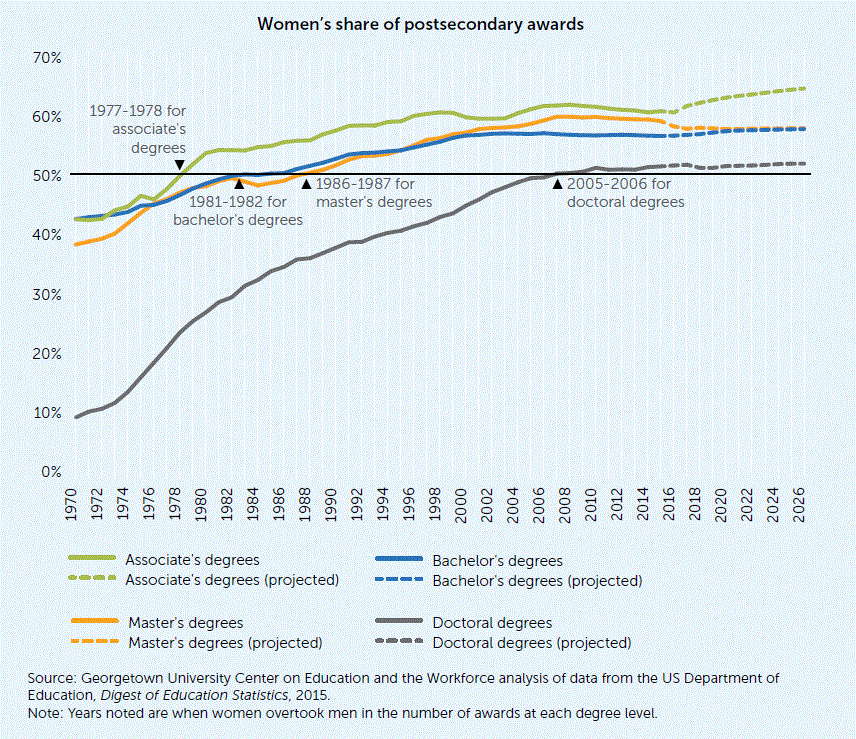
STEM:
Careers in the fields of science, technology, engineering and math, known as STEM, provide high-paying jobs (Carnevale, 2018). However, looking at data from 47 interest inventories, consistent findings indicate that females are more interested in people and males are more interested in things (Hyde, 2005). Along with this dichotomy, large gender differences favor males for interest in STEM fields. Further, large gender gaps are especially evident in engineering, mathematics, computer science, and physics (EMCP), which is a subset of STEM. This lack of interest may be one explanation for female under representation in these fields. Additionally, in societies in which people choose careers they feel will be highly interesting and fun, the largest gender gaps are found. In contrast, gender gaps are smaller in countries with developing economies where a stable salary is most important. All of these differences reflect cultural variables (Hyde, 2014). According to Master et al. (2016), adolescent females may avoid computer science courses because current prevailing stereotypes indicate to them that they do not belong. Consequently, computer science has one of the lowest percentages of women among STEM fields. Further, beliefs that STEM fields are not family-friendly and would interfere with family life may also keep females from pursuing these careers, and thus not earning high paying salaries.

Parents’ and teachers’ gender stereotypes regarding STEM fields may also discourage females from entering these fields. Female students may have internalized beliefs about female’s possessing less ability in STEM and other science fields, even if the evidence does not match these results and females are the majority in a science class. Colorado State University (2020) surveyed male and female students in science classes that were composed of majority female students and majority male students. In physical sciences classes, female students were in the minority and they had higher average GPAs. They were also 1.5 times more likely to earn an A or A- than the male students. However, both males and females in the class indicated that males performed better, that they would seek help from a male student more than a female student, and a male student was “best in class”. In biology classes, in which females outnumbered the males and performed better, females still identified a male student as someone they would seek help from and were more knowledgeable. Male students chose male and female students equally on all three measures.
Interestingly, when females perform well in STEM areas, the reasons given are that they work harder, are more attentive, and study harder than males. No mention is made regarding them being “naturally” strong in these areas. However, when females perform less well, the reasons given are that they are “naturally” less capable in STEM areas than males (Colorado State University, 2020). It is no wonder that these negative perceptions about female competence in science keeps women from pursing these fields.
Premed:
By the end of high school, females have higher grades, are more likely to attend college, and are more likely than males to indicate an interest in a medical career (Witherspoon et al., 2019). However, by the end of college, only 3.5 percent of the women who said they were interested in medical school took the Medical College Admission Test (MCAT), while 10 percent of males did. Female high school students’ overrepresentation in interest in medicine largely disappeared by the time students finished college and applied to medical school. The authors found that males and females enrolled in science courses required for their degree at the same rate in the first year of college. However, differences in retention begin to be noted during the second year of college, and it was not due to poor grades. Witherspoon et al. found that 96% of male students who earned an A in organic chemistry I went on to organic chemistry II, while 89% of female students earning an A moved on to the next course. This pattern of dropping out of classes continued, even when males and females earned the same grade. Why? Witherspoon et al. theorized that women dropping out was due to a lack of confidence in their abilities and not lower grades. Stereotype threat, and the belief that high grades were achieved only through effort and not ability, contributed to females leaving a premed program. The authors concluded that the loss of females in health care contributes to a significant loss in contributions to the field. Additionally, high performing women end up graduating with lower status, and thus lower paying careers.
Graduate Students and Faculty:
What happens when women pursue STEM, EMCP, and medical fields? Unfortunately, female graduate students and faculty often face an unwelcoming institutional climates. To investigate gender and racial bias in hiring in physics, Eaton et al. (2019) asked professors to read and evaluate the CV of a hypothetical recent Ph.D. Questions asked included the individual’s overall competitiveness, competence, likability, and the likelihood the person would be hired. All the information on the CV was the same except the gender and race of the person, which varied by manipulating the first and last name. Ninety percent of physics respondents were male, and they exhibited a gender bias favoring the male candidates as more competent and more hireable than the identical female candidates. An interaction between gender and race also occurred whereby Black and Latinx women and men candidates were rated the lowest in hireability. Because postdocs are a way to enter university faculty positions, not being hired for these positions can derail the careers for women and minorities.
Once women enter STEM fields, women scientists receive less federal funding for research. Oliveira et al. (2019) reviewed National Institutes of Health grants from 2006 until 2017 and found that first time female principal investigators received a median grant of $126,615, while first time male investigators received $165,721. Previous research had indicated that male researchers received higher financial startup support than females. This financial difference already places women at a disadvantage at the beginning of their careers as they have fewer resources for their research.
UCLA’s Higher Education Research Institute surveyed 20,771 full-time undergraduate faculty members at 143 college and universities between 2016 and 2017, and significant differences between male and female responses were found (Stolzenberg et al., 2019). When asked if they needed to work harder than their colleagues to be seen as a legitimate scholar, 61% of females agreed, while only 43.6% of males agreed. More than twice the number of females (36.2%) indicated they experienced either somewhat or extensive stress due to subtle discrimination than males (18%). Additionally, 60% of female faculty of color reported stress due to discrimination (60.1% of Black, 60.1% of Latina, 56.0% of Native American, and 59.0% of multiracial). Female faculty were also less satisfied with job benefits and salary than male faculty (43.5% versus 52.1%). Lastly, a significantly greater proportion of men (83.5%) than women (69.3%) agreed that female faculty were treated fairly at their institution.
What other role does gender play on career interest and employment? Despite the rise in the number of women who work outside of the home, there are some career fields that are still pursued more by men than women. Jobs held by women still tend to cluster in the service sector, such as education, nursing, and child-care worker. These jobs traditionally held by women tend to have lower status, pay, benefits, and job security (Bosson, et al., 2019). In recent years, women have made inroads into fields once dominated by males, and today women are almost as likely as men to become medical doctors or lawyers. Despite these changes, women are more likely to have lower-status, and thus less pay than men in these professions. For instance, women are more likely to be a family practice doctor than a surgeon or are less likely to make partner in a law firm (Ceci & Williams, 2011). In business, they are more likely to work in human resources than finance.
Women’s Lack of Career Advancement
What are the effects of internalized gender roles and stereotypes?
Since childhood, males and females have been socialized to adhere to gender roles. Managerial positions are seen as masculine and male leaders are expected to be assertive, dominant, competitive and achievement-oriented, while these same attributes are negatively ascribed to females. Further, compared to men, women are less likely to see themselves in positions of power and high status (Kossek et al., 2017). Even when qualified, women often choose not to enter male-dominated roles or seek high-level positions because of gender socialization. In addition to internalized gender roles, women may also face stereotype threat, or detrimental performance due to being judged and treated in ways that confirm negative stereotypes. Dealing with negative assumptions regarding one’s performance consume cognitive resources that could be directed toward work tasks, and instead these assumptions negatively affect work performance. Stereotype threat has resulted in anxiety, stress, negative thoughts and emotions, and a decrease in leadership aspirations among working women.

Do women prioritize their families over their careers?
In 2013, Sheryl Sandberg wrote a best-selling book encouraging women to “lean into” their careers in order to break through persistent glass ceilings (King, 2015). Sandberg identified institutional factors that hold women back occupationally, but also stated that women hold themselves back by not reaching for higher positions. In contemplating future families, Sandberg reflected that women make many small career decisions along the way they believe will be required to have a family, and thus actually “leave before they leave” (Sandberg, 2013, p. 93). Are women prioritizing families over careers, thus contributing to them “opting out” of their careers, or are there cultural and institutional factors that contribute to women being “pushed out” of their careers? Research indicates that there may be more of the latter.
In a review of the literature researching whether women “opt out” or are “pushed out” of careers, Kossek et al. (2017) identified several individual and organizational factors. At an individual level, women are more likely to prioritize a balance between their work and home life, while men are more likely to prioritize their careers. This dual centric identity requires women to choose positions that allow for greater work-family flexibility, thus limiting them from pursuing more advanced positions. At the same time, employers value work-centric employees who are committed to make work the main focus of their lives. Consequently, women are overlooked for advanced positions if they prioritizes both work and family equally.
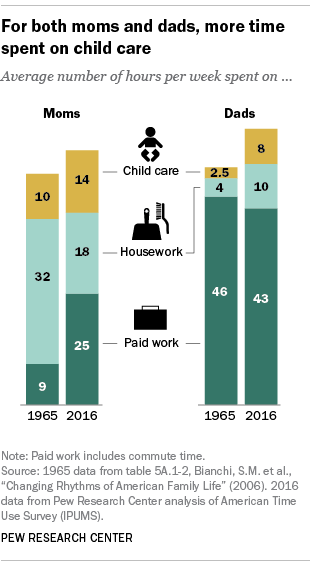 The current trend of employers expecting workers to be available 24/7 affects women more as they do the majority of the child care and typically do not benefit from the financial incentives that go along with the longer hours. Work-family conflict theory states, “work and family roles are incompatible, given conflicting expectations for time, energy, and behaviors,” (Kossek et al., 2017, p. 236). Although both mothers and fathers have increased the amount of time spent in child care, working mothers spend more time on child care and housework than working fathers (Livingston & Parker, 2019). Consequently, the level of stress resulting from a poor work-life balance can lead women to leave a job.
The current trend of employers expecting workers to be available 24/7 affects women more as they do the majority of the child care and typically do not benefit from the financial incentives that go along with the longer hours. Work-family conflict theory states, “work and family roles are incompatible, given conflicting expectations for time, energy, and behaviors,” (Kossek et al., 2017, p. 236). Although both mothers and fathers have increased the amount of time spent in child care, working mothers spend more time on child care and housework than working fathers (Livingston & Parker, 2019). Consequently, the level of stress resulting from a poor work-life balance can lead women to leave a job.
What are some hindrances to women’s career advancement?
The term “glass ceiling” was coined in 1984 by Gay Bryant, the former editor of Working Woman magazine (Kaiser & Wallace, 2016). The glass ceiling refers to the invisible barrier that prevents women from advancing into top positions. Women hold only 4.5% of CEO positions and 14% of top executive positions around the world (Noland, et al., 2016). In addition, Noland and colleagues found that in a study of nearly 22,000 companies worldwide, in 77% of those firms only 30% of women held an executive position or board seat. There were only 11 companies, or 0.05% of all the firms studied, where women held all the executive positions and board seats. Some researchers see the root cause of this situation in the tacit discrimination based on gender, conducted by current top executives and corporate directors, who are primarily male.
Morgan (2015) attributed this barrier to (1) male managers holding negative biases regarding the performance of female managers, and (2) male managers’ personal preferences not to work with women. These negative biases are also referred to as implicit bias, or unconscious attitudes and stereotypes. Implicit bias affects how women are perceived in leadership positions, even though leadership research indicates no gender differences in ability to lead. Because women are not implicitly associated with traits of successful leaders, they are not hired. Additionally, women are less likely to receive a mentor or have female role models that would assist them in moving into positions of leadership.
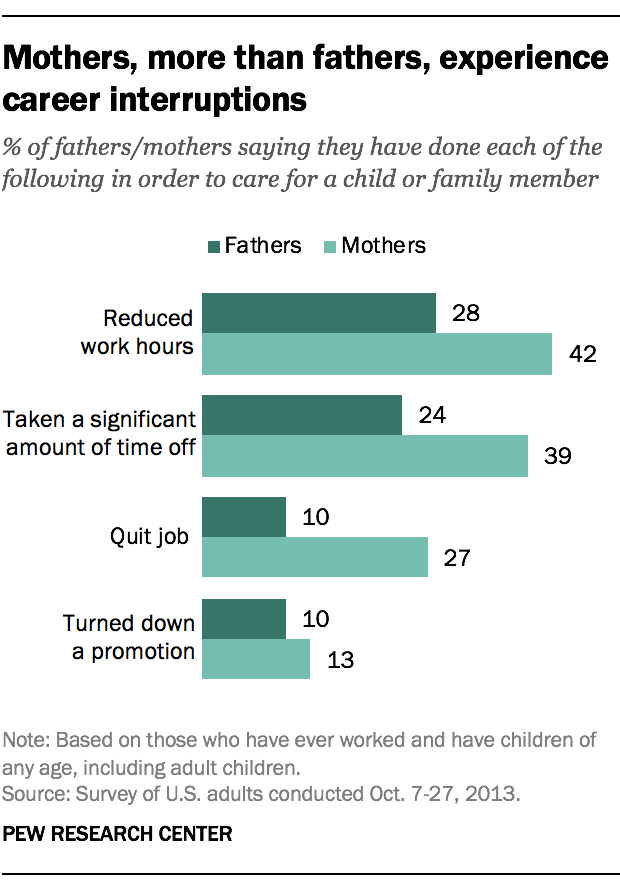
Other factors that may reduce women’s chances of top-level positions include a lack of participation in expatriate jobs, which are important to advancement in many companies. Because 90% of women professionals are in dual-career marriages compared to only 50% of men, finding a spousal job abroad is difficult and adversely affects a women’s ability to work overseas (Kossek et al., 2017). Further, more women than men experience career interruptions. Women who take time off from work to care for children or other family members indicate they are penalized, both financially and in career advancement (Pew Research Center, 2013).
Women also face what is known as the broken rung, or not being able to take the first step up into a management position. Without being able to move up the corporate ladder, they will not reach the top roles in management. Instead, they remain in positions with little opportunity for advancement. According to the most recent Women in the Workplace report (McKinsey & Co., 2019), only 72 women are promoted or hired into a manager role for every 100 men. Further, only 1 in 5 top executives are women, and for women of color, the number is only 1 in 25.
How are women judged when they attain a position of power?
When hired, women often face a hostile working environment. This is due to the role congruity theory, in which one’s characteristics should align with typical social roles. The perceived role of a “leader” is incongruent with the perceived role and stereotypical characteristics of a woman (Kossek et al., 2017). Women and men are expected to differ on the dimensions of communality and agency; that is, women should be nice and nurturing, while men should be competent and assertive (Parks-Stamm & Grey, 2016). In the workplace, women are penalized if they show low communality and high agentic behavior. Women are expected to assist others, and therefore are not rewarded for this behavior, but they will be penalized if they do not help others. However, males are rewarded not only for their agency, but also if they show helpful behavior, such as assisting a colleague. Men are not penalized if they are not helpful because they are not expected to be. Women leaders are constantly placed in this double-bind of needing to be communal and showing agency, without experiencing a backlash.
When women are hired for leadership positions, they may also face a glass cliff in which they are placed in precarious positions after a crisis and are set-up to fail (Ryan & Haslan, 2007). For instance, female lawyers are more likely than their male counterparts to lead a high-risk cases, and female politicians are more likely to be recommended to run in unwinnable seats (Bruckmuller et al., 2014). Female leaders are also more likely to be denied credit for their successes, and the display of negative emotions are attributed to their internal characteristics rather than external factors, while the opposite is true for males. Women in managerial positions face less feedback and fewer business connections (Novotney, 2019). Despite these perceptions and hindrances, there are no differences in leadership styles according to the research (Hyde, 2014). Not surprisingly, male leaders were rated somewhat more effective in positions that were consistent with the male role, while females were rated more effective in positions consistent with the female role.
Gender Wage Disparity
Using 2019 data, the American Association of University Women (2019) reported that the typical American woman earns $45,097, while the typical man earns $55,291. This discrepancy indicates that American women earn only 82 cents for every dollar earned by men. Using the same rate of increase, the pay gap will not close until 2093. Separating women into ethnic groups identify startling discrepancies. Compared to white, non-Hispanic men:
- Asian women earn 90 cents
- White women earn 79 cents
- Black women earn 62 cents
- Native Hawaiian or Other Pacific Islander women earn 61 cents
- American Indian or Alaska Native women earn 57 cents
- Hispanic women earn 54 cents
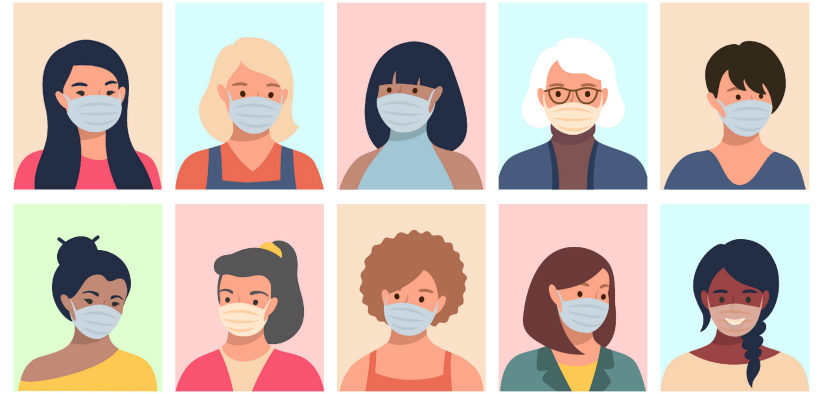
Covid-19 and Wages:
Covid-19 has affected women more than men in two main ways: Greater loss of jobs and greater exposure to the virus. During a typical recession, more men lose their jobs than women do because male-dominated manufacturing and construction are the hardest hit (Gupta, 2020). However, the hardest hit sectors with this pandemic include leisure, hospitality, education, and childcare, which are dominated by female employees. Of the 20.5 million jobs lost in April 2020, women held 55% of them. The unemployment rate for women 20 years and older went from 2.8% in February 2020 to 15% in April (Bureau of Labor Statistics, 2020). In contrast, for men 20 years and over, the unemployment rate changed from 2.9% in February 2020 to 13% in April. Women of color fared worse, with April 2020 unemployment rates for black women at 16.4 percent and Hispanic women at 20.2 percent. Because female-dominated jobs pay less, newly unemployed women lack adequate savings, thus increasing their chances of living in poverty.

As part of the precautions to decrease the spread of Covid-19, schools and childcare centers closed making home childcare an essential need. Because women have traditionally provided the bulk of childcare, continued employment for women proved difficult, as they needed to care for their children (Gupta, 2020). However, women working in healthcare and other required sectors remained employed, and consequently fathers increased their childcare responsibilities.
Although women did not lose their jobs working in these front-line positions, they were exposed more to the coronavirus. According to Boniol et al. (2019), women make up the majority of health care workers worldwide at almost 70%. In the U.S., that number is around 78% (Gupta, 2020). Compared to doctors, nurses are more closely involved in providing direct care, which increases females’ risk. Further, females are more likely to care for ill family members, also placing them at a higher risk than males.
Factors Affecting Wage Inequality:
There are many possible explanations for the wage gap. Occupational sexism involves discriminatory practices, statements, or actions, based on a person’s sex, that occur in the workplace. One form of occupational sexism is wage discrimination. In 2008, the Organisation for Economic Co-operation and Development (OECD) found that while female employment rates have expanded, and gender employment and wage gaps have narrowed nearly everywhere, on average women still have a 20 percent less chance to have a job. The Council of Economic Advisors (2015) found that despite women holding 49.3% of the jobs, they are paid only 78 cents for every $1.00 a man earns. It also found that despite the fact that many countries, including the U.S., have established anti-discrimination laws, these laws are difficult to enforce.
Education:
It has been argued in the past that education may account for the wage gap. However, the wage gap exists at every of education level (Bosson et al., 2019). Men with less than high school to men with graduate degree earn more than women with the same level of education. In addition, women now attain more associates, bachelor’s, and master’s degrees than men, and very similar levels of professional degrees and doctorates, according to a recent Census survey (U.S. Census Bureau, 2019). As the wage gap still exists in most occupations level of education cannot be the explanation. Instead, occupational segregation is a likely contributor to the overall wage gap, as women tend to work in very different occupations than men, and those jobs tend to have lower wages. In addition, the entry of women into a field tends to reduce the wages and prestige of the job. Mandel (2013) found that jobs typically held by men who saw the biggest influx of women into those careers, also saw the biggest drop in wages. When men enter occupations that have been historically held by women, as was the case with computer programmers, the status and remuneration increased (Bosson et al., 2019).
College Debt:
According to the American Association of University Women, women hold nearly two-thirds of the country’s outstanding student loan debt (Mensik, 2018). Reasons for this are many and include women attending college at higher rates, but then being paid less than men. Working in lower wage occupations, as well as earning less money in male-dominated fields, contributes to this inequity. Females also have additional expenses, especially child care, and are less likely to receive financial assistance from their parents than are males. Having difficulty paying off student loans can negatively affect women’s credit, which then makes it difficult to qualify for home mortgages and other loans.
Sticky Floors:
 Sticky floors, which keep low-wage workers, who are more likely to be women and minorities, from being promoted contribute to lower wages (Bosson, et al. 2019). Women are disproportionately in low-paid occupations, such as clerical, childcare, and service workers (Hegewisch & Ellis, 2015). They also get paid less than men in the same jobs. Men are not only being paid more in more masculine jobs, but also in jobs typically held by women.
Sticky floors, which keep low-wage workers, who are more likely to be women and minorities, from being promoted contribute to lower wages (Bosson, et al. 2019). Women are disproportionately in low-paid occupations, such as clerical, childcare, and service workers (Hegewisch & Ellis, 2015). They also get paid less than men in the same jobs. Men are not only being paid more in more masculine jobs, but also in jobs typically held by women.
Other factors include that more than half of men report having negotiated their salary when being hired, compared with 12% of women (Babcock et al., 2006). However, people perceive women who negotiate more negatively then they do men, as assertive women, but not men, are more likely to be penalized. Women are also more likely to have interruptions in their careers either through the birth of children, or relocation due to a change in their partner’s job. Women are also less likely to relocate for the sake of their families when a better job offer comes along, and employers know this. It has been suggested that one reason why males may be offered more money is to keep them from leaving (Baldridge et al., 2006). Additionally, men are more likely to work overtime.
Wage Inequality for the United States Women’s Soccer Team:
 A recent example of significant wage inequality occurred among athletes. The world witnessed the tremendous athleticism and soccer skills demonstrated by female players from 24 different countries during the 2019 Women’s World Cup. Amid the cheering at the end of the final match between the United States and the Netherlands, were chants of “equal pay” (Channick, 2019). Throughout the tournament, attention was focused on the discrepancy between what male soccer players earned compared to the female players. In winning the World Cup, the American women’s team earned $4 million as part of a $30 million prize pool (Peterson, 2019). In contrast, the French men’s team, who won the Men’s World Cup in 2018, earned $38 million as part of the $400 million prize pool. The Federation of Association Football (FIFA) promised to double the prize money to $60 million for the 2023 Women’s World Cup, but that still lags far behind the $440 million that will be given out for the Men’s World Cup in 2022. In the United States, the women’s soccer team generates more revenue and receives higher TV ratings than the men’s team, yet the women get paid significantly less. By winning the 2019 Women’s World Cup, each woman should receive $200,000, yet if the American men had won the 2018 Men’s World Cup, each would have received $1.1 million (Hess, 2019). Because of this discrepancy, in March 2019, 28 members of the women’s team filed a lawsuit against the United States Soccer Federation for gender discrimination and unequal pay (Channick, 2019). In February 2022, the U.S. women’s soccer team won their case and going forward they received back pay and were guaranteed equal pay commensurate with the men’s team (Das, 2022).
A recent example of significant wage inequality occurred among athletes. The world witnessed the tremendous athleticism and soccer skills demonstrated by female players from 24 different countries during the 2019 Women’s World Cup. Amid the cheering at the end of the final match between the United States and the Netherlands, were chants of “equal pay” (Channick, 2019). Throughout the tournament, attention was focused on the discrepancy between what male soccer players earned compared to the female players. In winning the World Cup, the American women’s team earned $4 million as part of a $30 million prize pool (Peterson, 2019). In contrast, the French men’s team, who won the Men’s World Cup in 2018, earned $38 million as part of the $400 million prize pool. The Federation of Association Football (FIFA) promised to double the prize money to $60 million for the 2023 Women’s World Cup, but that still lags far behind the $440 million that will be given out for the Men’s World Cup in 2022. In the United States, the women’s soccer team generates more revenue and receives higher TV ratings than the men’s team, yet the women get paid significantly less. By winning the 2019 Women’s World Cup, each woman should receive $200,000, yet if the American men had won the 2018 Men’s World Cup, each would have received $1.1 million (Hess, 2019). Because of this discrepancy, in March 2019, 28 members of the women’s team filed a lawsuit against the United States Soccer Federation for gender discrimination and unequal pay (Channick, 2019). In February 2022, the U.S. women’s soccer team won their case and going forward they received back pay and were guaranteed equal pay commensurate with the men’s team (Das, 2022).
Worldwide Gender Parity:
The World Economic Forum (2017) introduced The Global Gender Gap Report in 2006 as way of tracking gender based disparities between men and women in the world. The most recent report in 2017 analyzed 144 countries on gender equality in the areas of: economic participation and opportunity, educational attainment, health and survival, and political empowerment. Countries are then ranked to create global awareness of the challenges posed by gender gaps in different areas of the world. A parity rating of 100% would mean that females and males achieved equality on these measures. Results indicated:
- 68% gender parity was found worldwide across the four areas. Specifically, there was 96% parity in health outcomes, 95% parity in educational attainment, 58% parity in economic participation, and only 23% parity in political empowerment.
- The top spots were held by smaller Western European countries, particularly the Nordic countries as Iceland (88% parity), Norway (83% parity) and Finland (82% parity) occupied the top three positions.
- The United States ranked 49th with 72% gender parity.
- Following the current trends, it will take 100 years for global gender parity.
- Improving gender parity is expected to provide significant economic gains for a country and closing the occupational gender gaps would be one way to achieve this.
Salary History Ban (SHB):
Another way to improve gender parity is through the use of laws banning questions regarding a worker’s salary history. Several U.S. states, see table, have enacted a ban on employers asking job seekers this question. As a result employers in these states have switched from wage bargaining to wage posting in job advertisements. In other words, prospective job applicants know the expected salary range before applying for the job. Each state handles the issue differently, some bans only apply to the public sector, while others apply to all jobs in the state. Some states still allow applicants to volunteer this information, while others do not allow such questions on job applications or during interviews. There is no ban on a prospective employer asking an applicant their desired salary.
| State | Passed | Enacted | Employees Covered |
|---|---|---|---|
| Massachusetts | 8/1/16 | 7/1/17 | All |
| Puerto Rico | 3/8/17 | 3/8/17 | All |
| Oregon | 5/22/17 | 10/6/17 | All |
| Delaware | 6/14/17 | 12/14/17 | All |
| California | 10/12/17 | 1/1/18 | All |
| District of Columbia | 11/17/17 | 11/17/17 | Public Only |
| Hawaii | 1/19/18 | 1/1/19 | All |
| Vermont | 5/11/18 | 7/1/18 | All |
| Connecticut | 5/22/18 | 1/1/19 | All |
| Pennsylvania | 6/6/18 | 9/4/18 | Public Only |
| New Jersey | 1/14/19 | 1/1/20 | All |
| Illinois | 7/31/19 | 9/29/19 | All |
| North Carolina | 4/2/19 | 4/2/19 | Public Only |
| Maine | 4/12/19 | 9/17/19 | All |
| Washington | 4/25/19 | 7/28/19 | All |
| Colorado | 5/22/19 | 1/1/21 | All |
| Alabama | 5/30/19 | 9/1/19 | All |
| New York | 6/15/19 | 1/6/20 | All |
| Virginia | 6/20/19 | 7/1/19 | Public Only |
| Some states, such as Illinois, New York and New Jersey, enacted SHB laws much earlier that covered only the Public sector. Listed here is the current SHB laws for the state. Adapted from Bessen et al. (2020). | |||
These bans were initially pushed by women’s advocates to help close the gender wage gap, a recent study has shown that other minority groups have also benefitted from such bans (Bessen et al., 2020). Why the concern about employers asking people their prior salaries when seeking a new job? Many activists believe that that the knowledge about a worker’s prior salary history gives employers an unfair advantage in any salary bargaining, especially for groups, such as women and racial minorities, who may be underpaid due to discrimination in previous jobs. In other words, such questions may perpetuate the wage gap. In their comparison of the wages of workers who switched jobs both prior to and after a SHB had been put into effect, Bessen and colleagues found that women’s salaries raised 8.5% on average, and they were able to determine that 48% of the gender wage gap disappeared when an SHB was in effect. African American men and women saw even greater improvements, 16% and 14% average increase in the salary respectively when they switched jobs in states with SHB laws, suggesting that discrimination may play an even greater role for racial minorities. Overall, workers in states with SHB laws saw a 7.9% average increase in salaries when they switched jobs, while those in states without a SHB saw only a 3.9% average increase. SHB laws lift the veil of secrecy in salary negotiation for all groups of workers.
Men’s Careers
Due to the greater respect, benefits, and pay inherent in male-dominated careers, women have made strides in entering these fields. Between 2009 and 2017, approximately 23% of jobs traditionally held by men are now held by women (Hedreen, 2019). These include CEOs, lawyers, surgeons, web developers, chemists and producers, What about men entering female-dominated careers? Historically, female-dominated careers were seen as providing less status, less pay, and greater stigma for males to enter. Despite these constraints, 27% of female-dominated professions are now held by men. The table below displays the percentages of both females and males in stereotypical opposite-gender professions.
| Percentage of Females in Male-dominated Professions | Percentage of Males in Female-dominated Professions |
|---|---|
| Lawyers: 48% | Cooks (institution and cafeteria): 64% |
| Veterinarians: 48% | Merchandise displayers and window trimmers: 59% |
| Commercial and industrial designers: 48% | Retail salespeople: 58% |
| Marketing managers: 47% | Pharmacists: 50% |
| Optometrists: 43% | Education administrators (postsecondary): 49% |
| Management analysts: 43% | Elementary school teachers: 49% |
| Sales managers: 43% | Bartenders: 48% |
| Producers and directors: 42% | Insurance sales agents: 43% |
| Chemists: 42% | Market research analysts and marketing specialists: 42% |
| Coaches and scouts: 41% | Accountants and auditors: 41% |
| Private detectives and investigators: 41% | Technical writers: 42% |
| Emergency medical technicians and paramedics: 40% | Interior designers: 41% |
| Financial analysts: 40% | Fitness trainers and aerobic instructors: 40% |
Women who enter traditionally male occupations have faced barriers and discrimination. What are the experiences of men in traditionally female occupations? Many men experience their token status in female occupations as an advantage in hiring and promotion, a phenomenon referred to as the glass escalator (Dill et al., 2016). Feminist scholars have commented on how the cultural beliefs about masculinity and femininity are embedded in the structure of the world of work (Dill et al., 2016). Men are often “pushed” in subtle ways into positions that carry greater authority, prestige, and money. However, not all men experience the same advantage. Racial minorities are less likely to ride the glass escalator than are white males (Dill et al., 2016; Woodhams, et al. 2015) the same is true for disabled males (Woodhams et al., 2015).
Still, many males are uncomfortable entering female dominated occupations. One such career choice that males avoid is nursing, as 90% of all nurses are currently women (Vedantam, 2018). According to the Bureau of Labor Statistics (2020), healthcare occupations account for 13 of the 30 fastest growing occupations from 2019 to 2029. Because of aging baby boomers, demand for healthcare services will drive this projected employment growth, so it would seem a great career choice for everyone. However, women have traditionally held jobs in the health care field, and prior research indicates that if women are attracted to an occupation, then men hesitate to enter. Vandello and Bosson (2012) explain the reluctance of males to enter careers dominated by women as being due to precarious manhood, which was described in module one. Nursing is associated with being a female career, and choosing this occupation can alter a man’s perception of his gender status and how he is perceived by others. Consequently, a male is motivated to continually prove his manhood status to others and himself, and thus rejects a stereotypical female career. To encourage more men to enter nursing, Bosson encourages the rewriting of stereotypes by also promoting nursing as a masculine occupation, such as describing nursing as “dangerous” and “physically grueling” (Vedantam, 2018). Gender labeling careers can discourage qualified candidates from participating, and thus hold back both their own personal and financial goals.
Dangerous Jobs:
According to the Bureau of Labor Statistics (2019), there were 5,250 fatal work injuries recorded in the United States in 2018, a 2 percent increase from the 5,147 in 2017. Occupations with the highest death rates are those in male-dominated fields. These include: truck drivers, loggers, fishing workers, aircraft pilots and flight engineers, roofers, police and sheriff patrol officers, and taxi drivers and chauffeurs. The table below lists the fatal work injury rates per 100,000 full-time equivalent workers by selected occupations in 2018.

Sexual Harassment
According to the United States Equal Employment Opportunity Commission (2020), sexual harassment is a form of sex discrimination that violates Title VII of the Civil Rights Act of 1964. Title VII applies to employers with 15 or more employees, including state and local governments. It also applies to employment agencies and to labor organizations, as well as to the federal government. Unwelcome sexual advances, requests for sexual favors, and other verbal or physical conduct of a sexual nature constitute sexual harassment when this conduct explicitly or implicitly affects an individual’s employment, unreasonably interferes with an individual’s work performance, or creates an intimidating, hostile, or offensive work environment.
Sexual harassment can occur in a variety of circumstances, including but not limited to the following:
- The victim as well as the harasser may be a woman or a man. The victim does not have to be of the opposite sex.
- The harasser can be the victim’s supervisor, an agent of the employer, a supervisor in another area, a co-worker, or a non-employee.
- The victim does not have to be the person harassed but could be anyone affected by the offensive conduct.
- Unlawful sexual harassment may occur without economic injury to or discharge of the victim.
- The harasser’s conduct must be unwelcome (p. 1)
Keplinger et al (2019) further separates the EEOC definition into three main areas:
- Sexual coercion-threats towards those who will not comply with sexual requests or bribes in exchange for sex
- Unwanted sexual attention-sexual advances including inappropriate comments, staring, and touching
- Gender harassment-general gender hostility that is not necessarily sexual
The sexual mistreatment of women has gained significant attention with the #MeToo movement, begun in October 2017, and the #Timesup movement in January 2018. To determine if sexual harassment toward women subsequently decreased between 2016 and 2018, Keplinger et al. (2019) found that unwanted sexual attention and sexual coercion did in fact decrease, but gender harassment increased. Examples of gender harassment included coworkers making sexist remarks and displaying sexist material. A positive outcome from the study was that women felt more empowered to speak up regarding sexual harassment than previously.
Harassment in Male-dominated Fields:
Catalyst (2020) reported that in a 2017 survey, 28% of women working in male-dominated industries stated they had personally experienced sexual harassment, compared to 20% of women in female-dominated industries. A 2018 report by the National Academies of Sciences, Engineering, and Medicine (NASEM) indicated that 50 percent of female faculty in these fields said they had experienced “sexual coercion, unwanted sexual attention and gender harassment described as verbal and nonverbal behaviors that convey hostility, objectification, exclusion or second-class status from faculty or staff”, (Novotney, 2019, p .40). Additionally, sexual and gender minority women indicated higher levels of harassment. The higher rate of sexual harassment for women in these science-heavy fields reflected their college experiences as women pursuing male-dominated university majors experience higher levels of harassment than women earning other degrees (Catalyst, 2020). Moreover, it is not just women who experience greater harassment in such fields. Men in male dominated jobs, such as mining, reported higher rates of sexual harassment than in female dominated jobs, such as healthcare (Center for American Progress, 2018).
In the next module we will consider how gender impacts both physical health, and its role in both seeking and receiving treatment.

